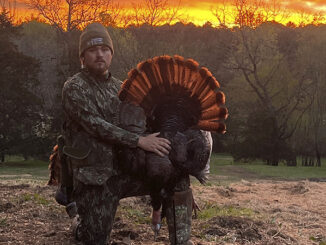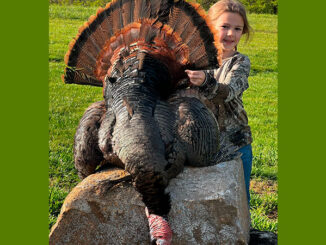
Spawn is approaching for yummy walleye
Some mountain gamefish are prized for their fight. Hook a bass, smallmouth or largemouth, and you’re in for some exciting action. Walleye, on the other hand, are prized for their taste. Hook a walleye and you’ll get very little action, but you will have a tasty meal. Many anglers say walleye are the best tasting of all freshwater fish, equal to wild trout in flavor and texture.
Late winter and early spring are prime fishing times for walleye because they are easier to locate. They usually begin spawning in February, depending on the weather, leaving deep water to move up tributaries. Spawning usually peaks in March; females lay their eggs and immediately return to the lakes. Males stay around for several weeks to fertilize the eggs. If large tributaries aren’t available, walleye will spawn along lake shorelines and shoals or the rip-rap of dams.
During spawning and in early spring, walleye inhabit shallow water. When water temperatures climb, they head for deep water.
Often called “pike,” walleye are actually members of the perch family. They have long, slender, silvery bodies with lighter-colored bellies. Average size is between 14 and 18 inches, and average weight is between ¾ and 1½ pounds. The state record, caught in Clay County’s Lake Chatuge in 1986, weighed 13 pounds, 8 ounces. The world record is 25 pounds.
A cool-water fish, walleye prefer lakes where maximum water temperatures are under 77 degrees.
Prime walleye lakes are Fontana Lake in Graham and Swain counties, Santeetlah Lake in Graham County, Lake Glenville in Jackson County and Lake James in Burke and McDowell counties.
Being a successful walleye angler requires patience and a light touch. Presentation must be slow, and as one veteran walleye fisher said, “You have to let them eat the bait” before you set the hook. When walleye are close to shorelines, a popular technique is to cast a leadhead jig to the bank and slowly work the line in, slowly raising and lowering the rod tip as you retrieve.
Danny Brower of Sylva, a former guide who fished Santeetlah and Fontana for almost 20 years, equates fishing for walleye with fishing for bass with plastic worms. “It’s more finesse fishing.”
Using ultralight spinning tackle and 4-pound test line, Brower ties on an eighth-ounce leadhead, slides a 2-inch lime-green or chartreuse curlytail grub on the hook and tips the hook with a nightcrawler. He then casts to a muddy shoreline, letting the bait sink slowly to the bottom. Usually, but not always, a strike will come on the fall. If he doesn’t get an immediate strike, he reels in slack line, slowly lifting the rod tip above his head and letting the bait slowly fall back to the bottom. He repeats this procedure until all the line is in and makes another cast.
A walleye doesn’t strike like a bass or a trout taking a lure. A walleye, more or less, lips the lure. “It’s very subtle,” Brower said. “If you feel the slightest resistance, treat it like a strike. Lower the rod tip, open the bail to let line out, let the fish take the bait, and slowly reel in slack. The hookset is applied only when you’re certain the fish is on,” he said.
About the only sure-fire way of detecting a “strike” is to watch the line.
“If it stops falling or moves sideways, a walleye has taken the bait,” Brower said. Often a strike will be little more than a slight thump.
“Walleye will try your patience,” Brower said. “You have to let them take the bait and not pull it away from them.”
Mark Rogers of Robbinsville has fished Lake Santeetlah most of his life.
“I’ve caught some big walleye in Santeetlah,” he said. “The largest one weighed a little over 12 pounds.’’
In early spring, Rogers does much of his fishing from the bank. The best time for this type of fishing is late afternoon and early evening when walleye move close to shorelines looking for baitfish. His arsenal includes a variety of lures and baits: nightcrawlers. live minnows, curlytail grubs, Shad Raps, Husky Jerk jerkbaits, Lucky Craft crankbaits, and other lures.
Rogers casts as far as he can, lets the lure or bait sink, and slowly reels in, often giving the lure or bait an occasional jerk. If he detects a strike, he opens the bail, lets the fish take the bait and “run a little bit before I set the hook.” Because leadheads and hooks often snag on rocks and debris, Rogers prefers “stout” line, at least 10-pound, and uses a medium-action spincast rig.
Randall Veal, owner of Santeetlah Marina, said many veteran walleye fishers prefer vertical fishing, using one-eighth to quarter-ounce Ice Jigs tipped with a curlytail grub or nightcrawler. Chartreuse, pink, or pearl-white colors are the preferred colors for spring fishing. After fishers locate walleye on their electronic fish-finders, they begin jigging, dropping and raising the lures among the fish. Late afternoon and early evening are prime times for vertical jigging..
For open-lake fishing, many anglers prefer trolling with downriggers, using Hopkins or Sutton spoons and combing the main lake channels.
If it’s action you want, go for the bass, but if you want a tasty meal, go for the walleye.








Be the first to comment